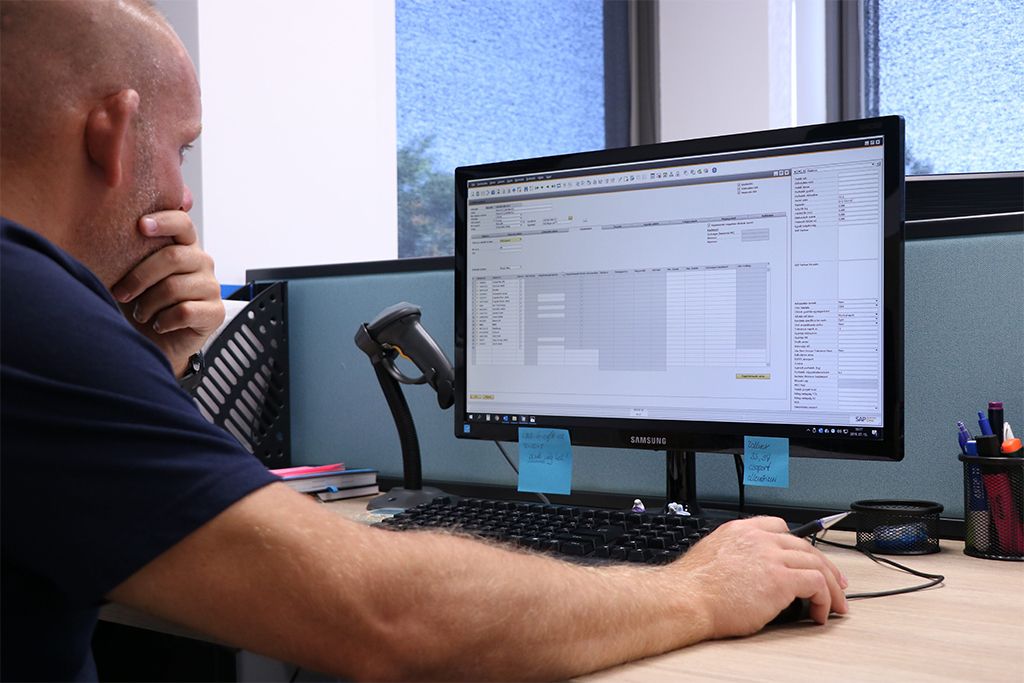One of the pillars of Industry 4.0 is that individual business and manufacturing systems should not operate in isolation, but should communicate with each other in real time. In a modern manufacturing company, it is now a basic expectation that enterprise resource planning (ERP) and production management (MES) systems work in sync. In this article, we will show you how SAP Business One and Pharis MES work together in practice – and what benefits it brings to Innomechanikai Kft. in manufacturing.
Characteristics of Industry 4.0
Here are the most important things to know:
Key features of Industry 4.0
- Digitalization – all processes become data-driven
- Real-time data collection and analysis
- Automation and robotics integration
- IoT – machines and sensors connected
- Artificial intelligence and machine learning
- Cyber-Physical Systems (CPS) – connecting the physical and digital worlds
- Cloud-based systems and scalable IT infrastructure
- Intelligent decision support (e.g. predictive maintenance, self-organizing production lines)
An example of how Industry 4.0 works
Imagine a factory where:
the machines automatically report their status to the system,
production management responds to orders in real time,
the ERP system (e.g. SAP B1) and MES (e.g. Pharis) automatically reconcile,
faults are predicted by sensors, not discovered afterwards,
The driver can also see where the production is from his mobile phone.
This is Industry 4.0 in action.
In what areas is it used today?
Industry 4.0 technologies are already being used in many industries and types of companies around the world, especially where production efficiency, flexibility or quality are key. Below is a list of the most common areas of application and specific examples:
Manufacturing (main area of use)
Automotive industry
Robotic production lines (e.g. ABB, KUKA)
Real-time quality control
Just-in-time logistics, automated warehouses
Mechanical engineering and metalworking
Connecting CNC machines to MES systems
Predictive maintenance, machine condition monitoring
Tool wear monitoring, automatic intervention
Electronics industry
Very sensitive quality requirements
Automated Soldering, Assembly, Testing
Digital traceability
Food and Pharmaceutical Industry
Traceability and documentation are important due to a strict regulatory environment
Sensory process monitoring (e.g. temperature, humidity)
Automation of labeling and packaging
Construction & Building Automation
Integration of BIM (Building Information Modeling) data with IoT sensors
Smart construction projects, material usage tracking
Automated maintenance cycles (e.g. elevators, HVAC systems)
Agriculture
Precision farming with drones and sensors
Automatic irrigation and nutrient dosing in real time
Automatic adjustment of machines (e.g. combines) based on soil condition
Logistics and supply chain
Automatic warehouse management (e.g. Amazon, Decathlon)
RFID-based tracking
Smart transport route optimisation
Healthcare and medical device manufacturing
3D printing for custom prostheses
Data-driven diagnostics
Monitoring the condition of hospital devices
Industry 4.0 in practice: The role of integrated ERP and production management systems in modern manufacturing H2
Industry 4.0 is not just a buzzword, but a real and challenging transformation that will radically change the way manufacturing companies operate. The goal of the Fourth Industrial Revolution is to make all levels of production – from strategic decisions to workshop-level operations – digitized, data-driven and automated.
One of the most important elements of this is the close integration of enterprise resource planning (ERP) and production management (MES) systems .
What does integration mean?
In the past, production and corporate governance often lived in separate worlds: production was done “by hand”, on paper or in spreadsheets, while management tried to track what was happening in the ERP. However, this gap has resulted in a lot of loss of information, errors and slow reaction times. One of the most important requirements of Industry 4.0 is that these systems communicate with each other in real time, automatically and reliably.
What is ERP and what is the role of MES?
Enterprise Resource Planning (ERP): for example, SAP Business One is a centralized system that manages a company’s finances, inventory, orders, customers, and even the creation of production orders.
MES (Manufacturing Execution System): for example, Pharis MES monitors, controls and documents the actual production process in real time – from the workshop level to management reports.
How do SAP and Pharis communicate?
The integration between the two systems enables automatic data flow in the following ways:
Transfer production orders:
Production orders are created in SAP B1 → they are automatically transferred to the Pharis MES system, where operators can start the work.
Feedback from production:
Production performance, quantities, scrap data, machine downtime, etc. are returned to the SAP system, where they are displayed in reports or automatically updated inventory.
Real-time Dubbing:
The connection between the two systems allows them to work with the same information at all levels of the company – up-to-date.
What are the benefits in practice?
Less manual data entry, therefore fewer errors.
Faster and more accurate decisions because all data is available in one place in real time.
Transparent production processes – see exactly where an order stands.
Better customer service because the order status can also be tracked.
Cost reduction, because unnecessary production, scrap, and inefficient work organization can be minimized.
Summary and Foresight
Industry 4.0 is not only a technological innovation, but also a change of attitude: a data-driven, connected and flexible manufacturing environment is no longer an advantage, but a basic requirement for competitive operation. The SAP Business One and Pharis MES The integration of systems enables production and business decision-making to speak a common language – in real time, reliably and transparently. That Innomechanikai Kft. Example shows that well-planned digitalization not only brings efficiency gains, but also creates long-term business benefits. Industry 4.0 is not the future – The present, and companies and their partners that recognize and incorporate their opportunities in time can build their future on a stable foundation.




